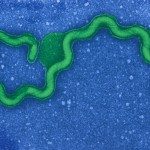Lien vers Pubmed [PMID] – 37372003
Lien vers HAL – hal-04132182
Lien DOI – 10.3390/antiox12061273
Antioxidants (Basel) 2023 Jun; 12(6):
Reactive oxygen species (ROS) are byproducts of oxygen metabolism produced by virtually all organisms living in an oxic environment. ROS are also produced by phagocytic cells in response to microorganism invasion. These highly reactive molecules can damage cellular constituents (proteins, DNA, and lipids) and exhibit antimicrobial activities when present in sufficient amount. Consequently, microorganisms have evolved defense mechanisms to counteract ROS-induced oxidative damage. Leptospira are diderm bacteria form the Spirochaetes phylum. This genus is diverse, encompassing both free-living non-pathogenic bacteria as well as pathogenic species responsible for leptospirosis, a widespread zoonotic disease. All leptospires are exposed to ROS in the environment, but only pathogenic species are well-equipped to sustain the oxidative stress encountered inside their hosts during infection. Importantly, this ability plays a pivotal role in Leptospira virulence. In this review, we describe the ROS encountered by Leptospira in their different ecological niches and outline the repertoire of defense mechanisms identified so far in these bacteria to scavenge deadly ROS. We also review the mechanisms controlling the expression of these antioxidants systems and recent advances in understanding the contribution of Peroxide Stress Regulators in Leptospira adaptation to oxidative stress.


